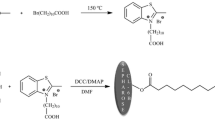Abstract
In this study we describe the activation with chloroformates of Trisacryl-GF-2000, a new synthetic gel support that is stable, hydrophilic, and contains large amounts of hydroxyl groups available for activation.
Of all the reagents tested, the activation withN-hydroxysuccinimide-chloroformate andp-nitrophenylchloroformate in organic solvents provides the best activation yield and subsequent coupling. When Trisacryl was activated in acetone with the chloroformates in the presence of 4-dimethylaminopyridine as base and catalyst, up to 30% of the hydroxyl groups, (i.e., 1/repeating unit) could be activated. Amino-containing ligands and proteins could be coupled to these carriers at pH 8 or higher. For better results in affinitychromatographic applications, spacers of ε-amino caproic acid or diaminohexane were introduced. The efficacy of these columns was demonstrated by purification of enzymes, antibodies, and antigens. The performance of these new columns were compared with that of Sepharose columns activated in various ways. In every case, the properties of the Trisacryl support proved superior with particular reference to the purity of the product obtained.
Similar content being viewed by others
References
Wilchek, M., Miron, T., and Kohn, J. (1984), inMethods in Enzymology (Jakoby, W. B., ed.),104, 3.
Kohn, J., and Wilchek, M. (1982),Enzyme Microbiol. Technol,4, 161.
Wilchek, M., and Miron, T. (1976),Biochem. Biophys. Res. Commun.,72, 108.
Brown, E., Joyeau, R., Racois, A., and Boschetti, E. (1979),Proc. Int. Symp. Aff. Chromatogr., Strasbourg, p. 37.
Racois, A., and Boschetti, E. (1978),Biochimie,60, 193.
Cuatrecasas, P., Wilchek, M., and Anfinsen, C. B. (1968),Proc. Natl. Acad. Sci. USA,61, 636.
Wilchek, M., and Miron, T. (1982),Biochem. Inter.,4, 629.
Gross, H., and Bilk, L. (1967),Ang. Chem.,79, 532.
Miron, T., and Wilchek, M. (1982),Anal. Biochem.,126, 433.
Miron, T., and Wilchek, M. (1981),J. Chromatogr.,215, 55.
Jacoby, W. B., Wilchek, M. (eds) (1974)Methods in Enzymology, vol34, 1–755.
Axen, R., Porath, J., and Ernback, S. (1967),Nature,214, 1302.
Wilchek, M., Oka, T., and Topper, Y. J. (1975),Proc. Natl. Acad. Sci. USA,72, 1055.
Hahn, T., Toker, L., Budilovsky, S., Aderka, D., Eshhar, Z. and Wallach, D. (1985),Proc. Natl. Acad. Sci. USA,82, 3814.
Author information
Authors and Affiliations
Rights and permissions
About this article
Cite this article
Miron, T., Wilchek, M. Activation of trisacryl gels with chloroformates and their use for affinity chromatography and protein immobilization. Appl Biochem Biotechnol 11, 445–456 (1985). https://doi.org/10.1007/BF02798640
Received:
Accepted:
Issue Date:
DOI: https://doi.org/10.1007/BF02798640




